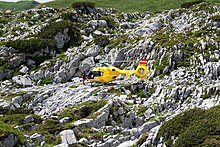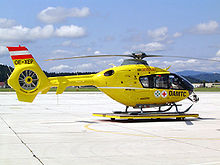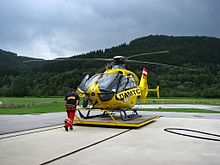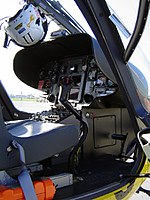Christophorus Air Rescue Association
| Christophorus Air Rescue Association (CFV) |
|
|---|---|
| purpose | Non-profit helicopter company for air rescue operations |
| Chair: | Oliver Schmerold, Reinhard Kraxner |
| Establishment date: | March 23, 1983 |
| Seat : | Vienna, Austria |
| Website: | oeamtc.at |
The Christophorus Flugrettungsverein (CFV) is the largest provider of air rescue in Austria and provides emergency helicopters in each of the nine federal states . It was founded by the regional associations of the ÖAMTC automobile club as a non-profit association. All year round, operations in medical emergencies, accidents and transfer flights are carried out from the 16 bases.
history
The Christophorus Air Rescue Association was founded in 1983 by the ÖAMTC after the Innsbruck surgeon Gerhard Flora criticized the state of air rescue in Austria. With Christophorus 1 in Innsbruck and Christophorus 2 in Krems , the first two emergency medical helicopters (NAH) were ready. In May 1984 the financing was secured by a contract with the social security agencies, in May 1985 the Federal Ministry of the Interior , the Austrian Armed Forces and the ÖAMTC decided to expand the air rescue nationwide. The helicopter originally flying under the name Christophorus 1 has been exhibited in the Vienna Technical Museum since December 2003 .
Between January and July 2002, the air rescue association took over one base of the armed forces and seven of the interior ministry after the state withdrew from air rescue for financial reasons. Three more bases were added by 2006. The helicopter fleet has been completely converted to EC 135 from Eurocopter .
In 2006 the association also entered into a cooperation with the Hungarian rescue service OMSZ, which converted its fleet to the helicopters of the ÖAMTC. At that time, the air rescue association with 24 EC 135 helicopters was the largest civilian EC 135 operator in Europe.
The association maintains 16 bases throughout Austria . In the winter months, six more HAT (Heli-Ambulance-Team) bases are added. These are operated in cooperation with the private NAH operator Wucher. The ÖAMTC is reacting to the increasing number of private helicopter operators. In a study commissioned by the Lower Austrian Regional Health Insurance Fund, this oversupply is criticized; 22 of the 38 bases active in the winter season could be closed without endangering the accessibility of all areas within 15 minutes.
The CFV works closely with the Austrian Red Cross , the Austrian Mountain Rescue Service and the Vienna Professional Rescue Service . 250 emergency doctors work for the organization.
The 16 bases completely cover Austria, on average the Christophorus helicopters arrive at the emergency location after 14 minutes. The emergency helicopter is requested via the usual Austrian emergency number 144 and is communicated via the locally responsible control center . The control center dispatcher decides whether a NAH operation is necessary based on the information given by the caller on the phone. If the responsible health insurance company does not finance the use of the helicopter, the association either bears the costs or bills them to the patient. In 2008, every third mission was not paid for by the social security agencies; due to this unresolved financing situation, the Christophorus Air Rescue Association terminated the contract to operate the rescue helicopter at the locations operated with the Ministry of the Interior at the end of 2010. When the contracts for the eight locations are re-tendered, the Ministry of the Interior provides for the patient's own contribution; the locations operated together with the federal states of Lower Austria, Upper Austria, Burgenland and Tyrol are subsidized from the respective state budget. For social reasons, the ÖAMTC refuses to bill patients and claims to have an annual loss of three to five million euros.
A third air rescue base in Styria has been announced for November 2019. It is set up in Sankt Michael in Upper Styria and is occupied by Christophorus 17.
Helicopter crew

In addition to the pilot, the helicopter crew consists of an emergency doctor , an emergency paramedic from the Red Cross or the Viennese professional rescue service and, depending on the type of operation, possibly a flight rescuer from the mountain rescue service or an alpine police officer. The medical devices and special equipment on board the helicopter correspond to the current standards and thus also enable special missions. From the two seats to the side of the patient, the attending emergency doctor or paramedic can monitor the patient's condition and provide further care. The crew is trained regularly, which causes annual costs of around 15,000 euros for pilots; for mountain rescue in alpine terrain, the crews are obliged to undergo mountain rescue training and annual advanced training.
The crews are on standby every day from sunrise to sunset; the earliest start of duty is 6 a.m. The helicopter is started a maximum of three minutes after the alert for an emergency operation.
Aircraft
The fleet now consists exclusively of the EC 135 manufactured by Eurocopter . The first of these machines was delivered to the Christophorus Air Rescue Association (OE-XEA) in 1997. Since then, the fleet has increased to a fleet of 28 machines (OE-XEA to OE-XEZ - excluding the OE-XEH that had an accident in Salzburg, see below under "Accidents" - and OE-XVA to OE-XVC). Until 2006, the Christophorus Air Rescue Association was the world's largest private operator of an EC 135 fleet.
The machines are equipped with equipment for various recovery techniques. For rope recovery with a rescue bag, a fixed rope of an adapted length is attached to the double hook system - developed by the Christophorus Air Rescue Association itself - on the underside of the helicopter. This enables the patient to be rescued at emergency locations where landing is not possible. The patient is flown on a vacuum mattress in the rescue bag together with the flight rescuer and paramedic to a suitable intermediate landing site, where he can receive further medical care. With variable rope recovery, the flight rescuer rappels down from a 10-meter rope up to 80 meters with the help of a special abseiling device and secures the patient on it, while the pilot holds the machine as calmly as possible in the air. The emergency doctor will only take care of the casualty at the intermediate landing area. A pirate recovery is used if, for example, a climber who has fallen or needs help is hanging on a rope on a steep rock face. An air ambulance paramedic secures the casualty on his rope and cuts his rope with a pair of cutters - after releasing the load. Furthermore, cable car rescue operations, crevasse rescue operations and skid rescue operations, which are very risky for the flight rescuer, are carried out by people who have broken into ice.
- designation
Christophorus 1 bis (2010) Christophorus 16 are the call signs of the aircraft that are stationed at the Christophorus locations of the same name. For example, the emergency helicopter stationed at Christophorus location 12 (Graz) always uses the call sign Christophorus 12 . After extensive service work, during which another machine is used at the respective location, it can happen that the aircraft released from service is assigned to a new location and accordingly renamed within the association. The logos of local sponsors can also change. However , this has no influence on the aircraft registration number of the aircraft. At Christophorus location 9 , for example, the helicopters OE-XEI, OE-XEN, OE-XEJ, OE-XEG, OE-XEC, OE-XEA, OE-XED, OE-XEO, came with the call sign Christophorus 9 over the years. OE-XEE and currently (July 2013) OE-XEG again in use.
In 2012, the first ÖAMTC helicopter Christophorus 11 in Klagenfurt was retrofitted for instrument flight, so that it can fly using the so-called cloud penetration method even in poor visibility .
Locations
Locations of the Christophorus emergency doctor helicopters |



| Paging name | Location | ICAO code | in operation since | in operation until |
|---|---|---|---|---|
| Christophorus 1 | innsbruck | LOJO | July 1, 1983 (LOWI) / May 2005 (LOJO) | - |
| Christophorus 2 | Krems | LOAG | September 1, 1983 | - |
| Christophorus 3 | Wiener Neustadt | LOAN | September 15, 1984 | - |
| Christophorus 4 | Reith near Kitzbühel | LOJC | December 10, 1984 | - |
| Christophorus 5 | Landeck / Zams | LOIL | January 1, 1993 | - |
| Christophorus 6 | Salzburg | LOWS | April 1, 2001 | - |
| Christophorus 7 | Lienz | LOKL | January 1, 2001 | - |
| Christophorus 8 | Nenzing | LOIG | January 1, 2001 | - |
| Christophorus 9 | Vienna | LOAJ | April 1, 2001 | - |
| Christophorus 10 | Linz | LOWL | April 1, 2001 | - |
| Christophorus 11 | Klagenfurt | LOWK | July 1, 2001 | - |
| Christophorus 12 | Graz | LOWG | July 1, 2001 | - |
| Christophorus 14 | Niederöblarn | LOGO | July 1, 2001 | - |
| Christophorus 15 | Ybbsitz | LOLY | June 26, 2004 | - |
| Christophorus 16 | Oberwart | LOGR | May 1, 2005 | - |
| Christopher 17 | Sankt Michael in Upper Styria | LODC | May 20, 2020 | - |
| Christophorus Europa 3 | Suben | LOLS | July 23, 2003 | - |
| Christophorus ITH | Wiener Neustadt | LOAN | July 1, 1999 | - |
- ↑ Note for base Christophorus 8 in Nenzing: The Christophorus Air Rescue Association provides the aircraft and the pilots for this base. The Vorarlberg mountain rescue service was commissioned by the state of Vorarlberg to organize and operate the air ambulance.
- ↑ Note for base Christophorus 9 in Vienna: The Christophorus Air Rescue Association provides the aircraft and the pilots for this base. The Viennese professional rescue service MA70 was commissioned by the State of Vienna to organize and operate the air ambulance.
- ↑ Note for Christophorus 11 in Klagenfurt: In 2012, the NAH moved into an ÖAMTC-owned hangar. Until then, he shared a hangar with the Interior Ministry's helicopter.
- ↑ Note for base Christophorus 17 in St. Michael in Upper Styria: Besides Christophorus 2, this is the only helicopter in Austria that is suitable for night flights and is ready for use around the clock.
- ↑ Note for base Christophorus Europa 3 in Suben: This base is operated jointly with the ADAC and is the first cross-border emergency helicopter project in Europe operated by two countries. Half of the crews come from Bavaria (D) and half from Upper Austria (A) and also look after these two federal states. The Red Cross control centers in Passau and Ried im Innkreis are responsible for coordinating helicopter missions.
Accidents
- On February 14, 1988, Christophorus 1 ( Alouette III ) crashed on the return flight of a rescue mission during which the patient had previously been handed over to the mountain rescue service. The ultimate cause is still unclear. In the crash, the emergency doctor and the paramedic were killed. The second paramedic and the pilot suffered serious injuries and were rescued by Christophorus 4.
- On August 19, 1992, Christophorus 5 ( Eurocopter AS 350 B2) in Tannheim (Tyrol) was caught by a hay rope that was not shown on the aeronautical charts and fell. The emergency doctor hanging on the approx. 10-meter-long mountain rope was killed and the pilot was seriously injured.
- On June 5, 1999 Christopher got 4 ( Eurocopter AS350 ) in Ellmau during the landing approach to a power line of the ÖBB , crashed while on the roof of a house and burned out completely. The ambulance was seriously injured and died 12 days later. The pilot and a medic were only slightly injured.
- On 1 May 2006 slipped Christopher 6 ( Eurocopter EC 135 , OE XEH) in Salzburg while approaching the roof landing site of the accident hospital the outer peripheral rim of the roof landing area and crashed to the lower position playground on the premises of the company kindergarten. The pilot was seriously injured, the other three crew members were slightly injured, and the patient suffered no further injuries. The playground was not in use at the time of the accident. In a first public statement, the pilot stated that he had noticed problems with the control of the tail rotor before the crash. Three years after the crash, the Aircraft Accident Commission published the complete report of the incident, which clearly documented human error in a technically perfect helicopter as the cause.
- On May 23, 2019, Christophorus 5 ( Eurocopter EC 135 , OE-XED) got out of control after a rescue mission in the Galzig area because the 42-year-old pilot of the machine suffered a medical emergency. When the patient was being loaded, the machine began to spin uncontrollably and remained a few meters from the landing site on a forest road crossing after the stern collided with a wall of snow. The patient who was already in the rescue bag fell from the aircraft, and another flight rescuer was slightly injured. The rescue helicopter Martin 2 was requested by the crew and the pilot was given first aid until it arrived. The helicopter called in transported the pilot and the injured flight rescuer, the actual patient was transported to Zams hospital in an ambulance. The wrecked Christophorus 5 was seized according to the instructions of the Innsbruck public prosecutor's office, and a court-sworn expert for aviation was commissioned to determine the cause of the accident.
For further accidents see: Air ambulance in Austria .
See also
literature
- On board by Christophorus 5. In: Rotorblatt No. 1/2018, pp. 24–30
Web links
- Website of the Christophorus Air Rescue Association
- Overview map emergency helicopter Austria on Google Maps
- The flying emergency room - a day on board Christophorus 9 Photo report about the everyday work of the crew on Austrian Wings - Austria's aviation magazine
Individual evidence
- ^ Statutes of the CFV , accessed on November 2, 2010.
- ↑ Imprint Christophorus Magazin
- ↑ Air ambulance in Austria on luftrettung.at, accessed on January 27, 2011.
- ↑ a b c ÖAMTC Air Rescue - Milestones on oeamtc.at, accessed on January 27, 2011.
- ↑ Martin Zirwig: Die Flugrettung in Österreich , diploma thesis from 2008 ( Online ( Memento of the original from January 4, 2011 in the Internet Archive ) Info: The archive link was inserted automatically and not yet checked. Please check the original and archive link according to the instructions and then remove this note .; PDF; 6.8 MB)
- ↑ ÖAMTC cooperation with Hungarian air ambulance on OTS from March 10, 2006, accessed on March 3, 2017
- ↑ Too many rescue helicopters over Austria? ( Memento of the original from June 5, 2011 in the Internet Archive ) Info: The archive link was inserted automatically and has not yet been checked. Please check the original and archive link according to the instructions and then remove this notice. on rettungsdienst.de, accessed on January 27, 2011.
- ↑ a b 20 years of Christophorus air rescue in Austria on luftrettung.at, accessed on January 27, 2011.
- ↑ As an example: Expensive use with the rescue helicopter. ( Memento from September 11, 2014 in the Internet Archive ) In: Kleine Zeitung from October 5, 2009.
- ↑ a b Turbulent year for ÖAMTC air rescue from January 6, 2009 on austrianwings.info, accessed on November 5, 2010.
- ↑ a b Andreas Wetz: Air Rescue: Patients should pay in the future from October 8, 2010 at Die Presse , accessed on November 5, 2010.
- ↑ Third emergency helicopter base fixed on ORF from April 4, 2019, accessed on April 4, 2019.
- ↑ Grace period in the dispute over air rescue on derstandard.at of November 19, 2010, accessed on January 27, 2011.
- ↑ Air rescue as part of the mountain rescue service ( Memento of the original from January 4, 2011 in the Internet Archive ) Info: The archive link has been inserted automatically and has not yet been checked. Please check the original and archive link according to the instructions and then remove this notice. at bergrettung.at, accessed on January 27, 2011.
- ↑ a b New heliport for Christophorus 11 on rth.info from November 5, 2012, accessed on December 25, 2012.
- ↑ Rescue flights also possible in foggy conditions on ORF of December 24, 2012, accessed on December 25, 2012.
- ↑ Note Flughafenstrasse 51, 8073 Feldkirchen bei Graz, a little south of the terminal building and aviation museum
- ^ Air rescue website: Chronicle.
- ↑ Pilot: "I noticed a technical problem". On salzburg.orf.at on June 6, 2006, accessed on February 9, 2010.
- ↑ BMVIT investigation report (PDF; 2.9 MB), accessed on March 30, 2010.
- ↑ Emergency pilot during rescue: injured person fell in St. Anton from the helicopter Tiroler Tageszeitung on March 24, 2019








